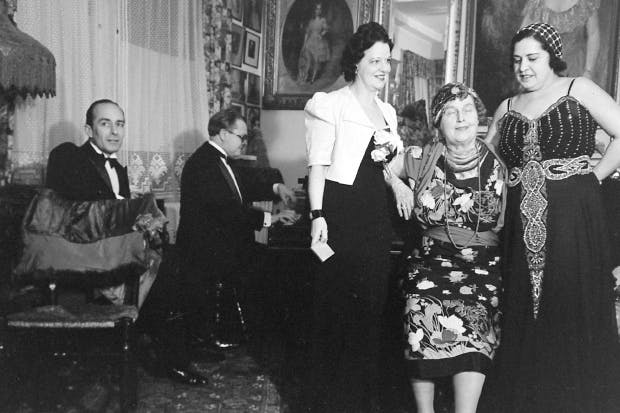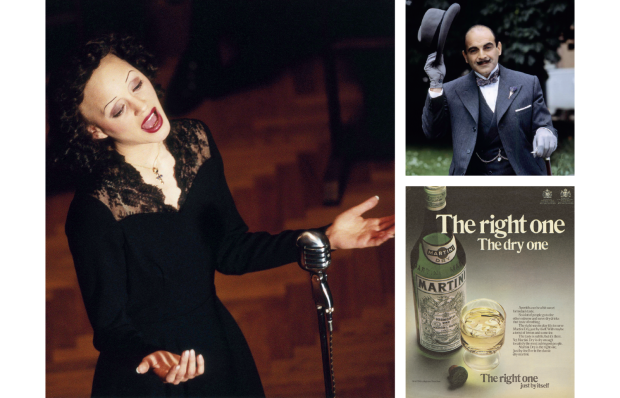When the Fat Lady Sings, everyone is primed to chortle, even if she is Montserrat Caballé and doing it wonderfully well. Hergé’s cartoon creation of Bianca Castafiore embodies the type: with her flaxen plaits and heaving embonpoint, she is a ridiculously bad fit for the simpering virginal heroine of Gounod’s Faust, particularly when carolling her Jewel Song at such a pitch that an agonised Tintin and Captain Haddock are forced to cover their ears. But at least Madame Castafiore has a brilliant international career: what about the Fat Lady who Can’t Sing — the diva deluded into thinking she is a nightingale when in fact she is nothing but a crow?
Two recent films explore this tragicomic syndrome. Both are based on the case of Florence Foster Jenkins, an American soprano of the interwar years whose dreadful recordings of classic songs and arias have been cult bestsellers for 70 years. Marguerite, released earlier this year, fictionalises the story in a Parisian and Proustian setting; Florence Foster Jenkins, which is in cinemas now, follows the known facts more closely and stars Meryl Streep, no less.
As it stands, the tale of Foster Jenkins looks tall, if not fishy. Born in 1868 into a wealthy Pennsylvanian family, she was a ‘child prodigy’ pianist prevented by her repressive father from following her passion for music professionally. A doctor with whom she eloped is thought to have infected her with syphilis, but after he vanished from the scene, she inherited money from her parents and took up with a bogus English Shakespearean actor, St Clair Bayfield, who became her common-law husband and manager.
Shortly before the first world war, unable to continue as a pianist because of an injury, she began singing at soirées in fashionable salons and at ‘subscription only’ recitals in hotel ballrooms across New York and New England. She also hosted something exclusive called the Verdi Club, where she presented herself as the regal figure in elaborate tableaux vivants.
It appears that she had some vocal tuition, and it is conceivable that she may originally have been no worse than a lot of after-dinner lady singers of the time. But as she aged and her control of pitch and rhythm declined (an effect of syphilis?), her act became eccentric to the point that she accumulated a cult following who came only to snigger.
To what extent she was aware of this and cynically capitalised on her bonkers reputation to make money is unclear. But the climax came in the early 1940s when she decided to enter a studio and record nine tracks — the legacy on which her fame now rests. Finally, in 1944, at the over-ripe age of 76, she was moved to hire Carnegie Hall for what would be her only public performance, the sold-out audience for which included Cole Porter. A few days later she died, reportedly heartbroken at the scathingly satirical reviews.
Although Foster Jenkins appears to have been a pretty unpleasant piece of work — mean, snobbish, vain and insistent on being addressed as Lady Florence — much of what is known about her comes from an unreliable source, namely her pianist Cosmé McMoon, an old rogue who ended up running a male brothel. A new biography by Jasper Rees exposes some of the myths and also contains some revelations.
Foster Jenkins was not unique. As we all know, singing can be an intensely pleasurable activity, so long as one cannot hear oneself. Many women of her era and class nursed the dream of becoming a star of grand opera — a destiny once considered wildly glamorous — and with the help of private income, iron will and the flattery of false friends, several of them made a career of sorts on its distant fringes.
A CD on the Homophone label entitled The Muse Surmounted usefully presents the surviving recorded evidence, together with a booklet providing biographical sketches of the culprits.
Is there something touchingly heroic about their fearless self-exposure? Or do they merely illustrate the extent to which people can pathetically kid themselves? Most of us are wise enough to keep our versions of ‘Casta diva’ or ‘Nessun dorma’ confined to the bathroom; these dames were not.
Take Olive Middleton, for example. Born in England in 1891, she made a genuine name for herself in the 1920s, working under Thomas Beecham and appearing in solo roles at Covent Garden. But after the war she and her husband emigrated to the USA, a move that seems to have both shaken her marbles and corroded her vocal cords.
Throughout the 1950s she continued to star in leading roles such as Norma and Tosca for a threadbare outfit called La Puma Opera, keeping alive the glorious traditions of yesteryear in singing that makes up in wild ambition what it lacks in accuracy, security and refulgence. Her recording of the ‘Miserere’ from Il Trovatore is shot through with anguish, and not in a good way.
More obviously a straight fraud was Madame Mari Lyn, a middle-aged matron from suburban Queens, who in the 1980s broadcast her own show on cable television. Shrouded in a grotesque blonde wig, thick spectacles and a series of décolleté gowns heavy on sequins and gold lamé, she sang any operatic aria that came her way in a tremulous soprano that alternated between a Banshee wail and a Bronx rasp, adding her own inimitably banal commentary between each number.
She was also a liar and huckster. She once faked an award ceremony, during which Madam was ‘surprised’ to receive a ‘Best New Operatic Voice of the Year’ trophy, presented by officers of the ‘Della Rosa Foundation of Palermo’. Taking out advertisements in the trade press, she proclaimed totally fictitious appearances with the ‘Philadelphia La Scala Opera’ and an association with the ‘Russian Prince Alexis Orloff’.
Even more bizarrely, she issued LP recordings of her effusions under a meticulous counterfeit of the Philips label, their covers emblazoned with accolades purloined from the press reviews of Joan Sutherland and stickers announcing ‘Grand Prix — Academie du Disque Française’.
The joke, of course, soon wears thin. Most of these ladies were at bottom merely fantasists in need of psychiatric attention — and the ghastly noises they make are about as funny as a pratfall or those plays about plays that go wrong.
Much more interesting (indeed an essential study for all students of the art) are the bloopers assembled on YouTube under the monicker of Perle Nere (‘Black Pearls’). This is a collection of vocal accidents and disasters, complete with incisive scholarly commentary, largely taken from pirated recordings of live operatic performances and perpetrated by some of the greatest names in the business, including Caruso, Domingo, Pavarotti, Tebaldi, Caballé and Gobbi.
Witnessing these highly trained and experienced singers skidding on the high wire, one can begin to understand what a delicate and complex art opera singing is. We can smugly laugh at this deranged sisterhood when its votaries lose the beat, veer into the wrong key, crack on the high note or allow intonation to sag. But when Tebaldi and Pavarotti do it too, the effect isn’t so much trivially ludicrous as downright shocking.
Got something to add? Join the discussion and comment below.
Get 10 issues for just $10
Subscribe to The Spectator Australia today for the next 10 magazine issues, plus full online access, for just $10.














Comments
Don't miss out
Join the conversation with other Spectator Australia readers. Subscribe to leave a comment.
SUBSCRIBEAlready a subscriber? Log in